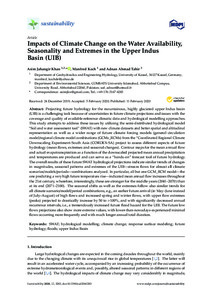| dc.date.accessioned | 2020-02-20T10:43:26Z | |
| dc.date.available | 2020-02-20T10:43:26Z | |
| dc.date.issued | 2020-02-11 | |
| dc.identifier | doi:10.17170/kobra-202002201011 | |
| dc.identifier.uri | http://hdl.handle.net/123456789/11462 | |
| dc.description.sponsorship | Gefördert durch den Publikationsfonds der Universität Kassel | ger |
| dc.language.iso | eng | eng |
| dc.rights | Urheberrechtlich geschützt | |
| dc.rights.uri | https://rightsstatements.org/page/InC/1.0/ | |
| dc.subject | SWAT | eng |
| dc.subject | hydrological modelling | eng |
| dc.subject | climate change | eng |
| dc.subject | response surface modeling | eng |
| dc.subject | future hydrology | eng |
| dc.subject | floods | eng |
| dc.subject | upper Indus Basin | eng |
| dc.subject.ddc | 630 | |
| dc.title | Impacts of Climate Change on the Water Availability, Seasonality and Extremes in the Upper Indus Basin (UIB) | eng |
| dc.type | Aufsatz | |
| dcterms.abstract | Projecting future hydrology for the mountainous, highly glaciated upper Indus basin (UIB) is a challenging task because of uncertainties in future climate projections and issues with the coverage and quality of available reference climatic data and hydrological modelling approaches. This study attempts to address these issues by utilizing the semi-distributed hydrological model “Soil and water assessment tool” (SWAT) with new climate datasets and better spatial and altitudinal representation as well as a wider range of future climate forcing models (general circulation model/regional climate model combinations (GCMs_RCMs) from the “Coordinated Regional Climate Downscaling Experiment-South Asia (CORDEX-SA) project to assess different aspects of future hydrology (mean flows, extremes and seasonal changes). Contour maps for the mean annual flow and actual evapotranspiration as a function of the downscaled projected mean annual precipitation and temperatures are produced and can serve as a “hands-on” forecast tool of future hydrology. The overall results of these future SWAT hydrological projections indicate similar trends of changes in magnitudes, seasonal patterns and extremes of the UIB—stream flows for almost all climate scenarios/models/periods—combinations analyzed. In particular, all but one GCM_RCM model—the one predicting a very high future temperature rise—indicated mean annual flow increases throughout the 21st century, wherefore, interestingly, these are stronger for the middle years (2041–2070) than at its end (2071–2100). The seasonal shifts as well as the extremes follow also similar trends for all climate scenario/model/period combinations, e.g., an earlier future arrival (in May–June instead of July–August) of high flows and increased spring and winter flows, with upper flow extremes (peaks) projected to drastically increase by 50 to >100%, and with significantly decreased annual recurrence intervals, i.e., a tremendously increased future flood hazard for the UIB. The future low flows projections also show more extreme values, with lower-than-nowadays-experienced minimal flows occurring more frequently and with much longer annual total duration. | eng |
| dcterms.accessRights | open access | |
| dcterms.creator | Khan, Asim Jahangir | |
| dcterms.creator | Koch, Manfred | |
| dcterms.creator | Tahir, Adnan Ahmad | |
| dc.relation.doi | doi:10.3390/su12041283 | |
| dc.type.version | publishedVersion | |
| dcterms.source.identifier | ISSN 2071-1050 | |
| dcterms.source.issue | Issue 4 | |
| dcterms.source.journal | Sustainability | eng |
| dcterms.source.pageinfo | 1283 | |
| dcterms.source.volume | Volume 12 | |


